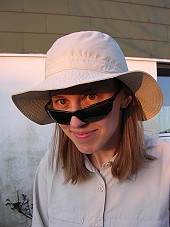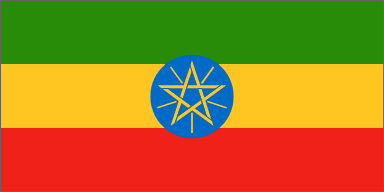
MARTINA'S WORLD TRIP
ETHIOPIA: May 18 - June 1, 2004


(Übersetzungshilfe)
 |
MARTINA'S WORLD TRIP ETHIOPIA: May 18 - June 1, 2004 |
|||||||
 |
||||||||
 |
Your Dictionary
(Übersetzungshilfe) |
|||||||
| Wednesday, May 19th, 2004 - Addis Ababa I | |||||||
| Wednesday, May 19th, 2004 - Addis Ababa I When I woke up today, I first made myself familiar with the place I was staying at. (Last night it was too dark and I was too tired to look around.) First conclusion: My room was okay. Very simple but clean and with a sink. This morning, water was running. Of course only cold but who cares. There were shared toilets and a shower in the corridor but as it turned out later, there were not many other people on this floor, so it wasn’t too bad to share bathrooms. The toilet had neither a seat nor a flush but hey, there was a bucket of water to use for flushing. At least the shower had the tremendous luxury of warm water! Overall, it wasn’t too bad. A totally different league than the places we stayed at in Egypt but here I paid less than 5 Euro per night, so what else can you expect. It seemed that my lonely low budget travelling had finally begun. This was what it would be like for the coming months. Somehow a little scary. I decided to “take the bull by the horns” and go for a walk. Equipped with my faithful Lonely Planet Guide I just set off. I had no clear target and just wandered around, trying to digest the different impressions compared to what I had just got used to in Egypt. At first, Addis Ababa almost looks like a Western capital. At least in the city centre you find a lot of modern buildings, shops and cars. Only if you look a little closer, you see the slums of small huts and mud streets squeezed in between the modern quarters, and you realise that the shops and many cars almost look like coming straight from the last century. Goats and donkeys are trotting around in the residential areas, people sell bananas and grains from tiny wooden stalls in the streets and women carry babies, huge loads wrapped in plastic bags or piles of wood on their back. In business areas with more shops, a lot of old or mutilated people are begging, young children in dirty clothes that are usually too large, sell tissues or chewing gum, and lots of boys try to make some money by cleaning the shoes of those who can afford to have any. Ethiopia is one of the ten poorest countries in the world - here I got a glimpse of it. Still, people in Addis are probably much luckier than the rest of most Ethiopians. Despite its huge size - Addis Ababa is the third largest city in Africa - it retains a small-town feeling. Yes, the streets are crowded and at times quite noisy, but the air is good and the place has nothing in common with Cairo, for example. Even the traffic and public transport seem to be more civilised. At least, buses ride with their doors closed and their system of so-called ‘mini-buses’ seems totally chaotic at first but then turns out to be very efficient and cheap on top. It basically consists of an extensive network of small blue and white minibuses that go around all over town. Their stops are not marked, neither would you find any information on schedules or prices, but once you get used to it, the system works well: Just check out the road on which your destination lies and wait for a minibus to pass by in the right direction. The conductors shout out the names of the main destination of the bus. If you hop on, don’t be surprised if the bus doesn’t move on immediately - it will only leave once all 11 passenger seats are full… After a couple of hours, it was around lunch time and I was happy to realise that I was close to the Goethe Institut, a German cultural centre existing in many foreign countries. Suddenly, I felt this urge to go there, just to taste a bit of home. I had never been in a Goethe Institut before, so I had no clue what to expect (Luna, I was thinking of you!). It turned out to be a place where German language classes were held in several classrooms along a corridor where paintings of a local artist were exposed. In a big sort of library, lots of German books were available for reading, as well as different German magazines and newspapers, more or less a week old. Some people were working at a few computer stations, others were concentrated reading, working or studying. One guy looked very German but all the rest were locals. What struck me most was the peace and silence in this place. What a difference compared to the noise and bustle in the streets! I sat down in the library and took a newspaper. It was wonderful, just to sit there, and somewhat feel being close to home. After a while a black guy sat down at my desk. He introduced himself as Cheru and spoke very well German! We started talking and he offered to show me around in Addis just to be able to practice some German in exchange. I was hesitating at first but then I thought it was better than being alone and he seemed to be a nice guy. He said he would show me a place from where we would have a great view over the city. It sounded like this place was almost around the corner, so I agreed. In the end it turned out that he meant the Entoto Mountains north of the city. Getting there took us almost two hours although we jumped on a bus twice! Most of the time, however, we were walking uphill which I found VERY exhausting. I had been walking all morning and struggled with the thin air. - Did you know that Addis Ababa lies at an altitude of 2500 m and thus is the third highest capital in the world? I think in the beginning Cheru found my condition rather amusing, although later he probably got worried. At times I felt ashamed about myself, especially looking at all those little girls and young women carrying what seemed like a ton of firewood on their back. From behind, it looked like a huge pile of wood on legs. Their backs bent down almost 90 degrees, they probably had been walking at least as long as I had today, so who was I to “suffer” from my little rucksack? In the end, we did quite a few breaks just for me to catch my breath but Cheru didn’t understand when I tried to explain him about the air difference and why it made me dizzy. Finally we arrived at the top of the hill. Well, apparently we could have gone up a little higher to visit a small church but I refused to climb any further. The place we sat down was good enough for me and we could clearly enjoy the view over Addis from here. It was really beautiful but unfortunately too foggy to take some good pictures. What was funny was when Cheru discovered moles on my skin. Obviously, black people do not have any and he couldn't believe white people just get them. He tried to rub them off like dirt and was amazed they wouldn't go. When I told him about the impact of sun and that white skin can actually get red and burned, he was totally fascinated... so cute! On the way back to town we took the bus and yes, it is true that they take chicken on the bus here! By now it was around 3:30 pm and I was getting pretty hungry. So I invited Cheru for a snack at a little kiosk in the street and it was the first time I tried Ethiopian cake. Result: Very dry and hardly possible to swallow without drinking at the same time. - Unfortunately, I didn’t find much better cake anywhere else in Ethiopia… As I still wanted to visit the Ethnological Museum, Cheru and I said good-bye but made an appointment for tomorrow evening. The Ethnological Museum is located in Haile Selassie’s former palace (he was Ethiopia’s last Emperor until 1974), which nowadays is home to the main campus of Addis Ababa University. According to my guidebook, the museum is supposed to be “undoubtedly the best in Ethiopia” - and they are right. Well, since it is the only one I’ve been to, I cannot compare it with any other museum but this one is EXCELLENT: The exhibition starts with artefacts and handicrafts from the different tribes of Ethiopia, displayed in a very original way. What makes this section outstanding is the thematic approach and layout based upon the human life cycle. The tour begins with the foundation myths, then comes Childhood with birth, games, rites of passage and traditional tales. Adulthood deals with beliefs, nomadism, traditional medicine, war, pilgrimages, hunting, body culture and handicrafts. The last topic is Death and Beyond, with burial structures, gravestones and tombs. Within these stages, different topics are addressed through different ethnic groups. Thus, the exhibition gives great insight into the many rich cultures of the people of Ethiopia. Later on I would remember lots of what I learned here when meeting the different tribes in the OmoValley. Other rooms on the same floor show the preserved bedroom and bathroom of Emperor Haile Selassie. He actually sat on a baby blue toilet! The 2nd floor is dedicated to traditional Ethiopian instruments. Drums, flutes, finger pianos, rattles, trumpets and lyres are on display in several small cubicles and you can hear different music played in each room. Another section of the museum focuses on religious art. The collection of icons here is the largest and most representative in the world! Overall, it was a great visit. Actually, I don’t remember what I did this evening but probably not much. I think I went to an internet café. Oh yes, and I met Sherif! He is one of these guys hanging around in the street, looking for tourist ‘victims’ like me. Well, at least he had this ID card of the local tourism office, stating he was an official agent (God knows if that was for real). He invited me for a drink and I think I only accepted because I wanted to get some information about groups I could possibly join for a trip to the South. He didn’t know of any tours being organised these days but he told me he would keep his ears open and let me know if there were some others travellers around who were looking for the same kind of tour. He was nice and “motivated to help” but I should have known that he would ask for a commission in the end… |
|||||||